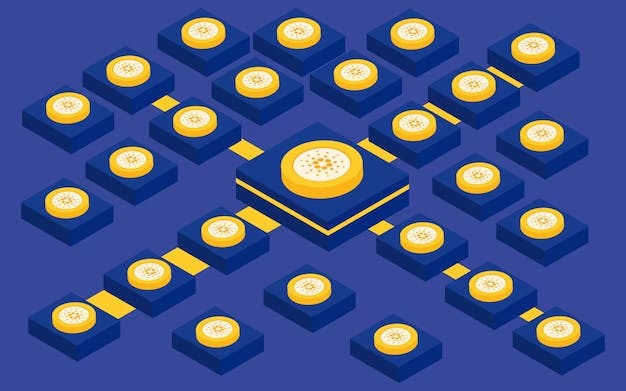
Blockchain technology has opened a whole new world of opportunities and possibilities for businesses, investors, and consumers alike. One area where blockchain is having a significant impact is in the realm of asset tokenization. Asset tokenization refers to the process of converting an asset, whether it be real estate, art, or commodities, into a digital token that can be traded on a blockchain network. This process has the potential to revolutionize the way we think about ownership, investment, and trading.
The idea of asset tokenization is not new, but the emergence of blockchain technology has made it easier, more secure, and more transparent. Blockchain technology allows for decentralized asset tokenization, meaning that assets can be tokenized and traded without the need for intermediaries such as banks or financial institutions. This has the potential to make asset ownership and investment more accessible and democratized.
One of the key benefits of blockchain-based asset tokenization is the increased efficiency and speed of transactions. Traditional asset transfers can be slow and costly, but blockchain technology allows for near-instantaneous transfers at a fraction of the cost. Additionally, the transparency and immutability of blockchain technology mean that all transactions are recorded and cannot be altered, providing a higher level of trust and security for all parties involved.
What is Decentralized Asset Tokenization?
Asset tokenization refers to the process of creating digital representations of physical assets such as real estate, art, and even gold. These digital assets, or tokens, can then be traded on blockchain-based marketplaces, allowing for increased liquidity and fractional ownership. Decentralized asset tokenization takes this a step further by removing the need for intermediaries, such as banks or brokers, to facilitate these trades. Instead, trades can occur directly between buyers and sellers, reducing costs and increasing efficiency.
Benefits of Decentralized Asset Tokenization
One of the primary benefits of decentralized asset tokenization is increased liquidity. Traditional assets such as real estate or art can be difficult to sell quickly, as finding a buyer with the necessary funds can be a time-consuming process. By tokenizing these assets, they become easily tradable on blockchain-based marketplaces, allowing for increased liquidity and faster transactions.
Another benefit of decentralized asset tokenization is fractional ownership. Traditional assets often require a large upfront investment, making them inaccessible to many investors. By tokenizing these assets, they can be divided into smaller units, allowing for fractional ownership. This means that more investors can participate in these markets, providing a wider pool of capital for asset owners.
Blockchain's Role in Decentralized Asset Tokenization
Blockchain technology is the perfect fit for decentralized asset tokenization. It provides a secure, transparent, and tamper-proof ledger for recording ownership and transaction details. By using smart contracts, rules for the ownership and transfer of these assets can be encoded directly into the blockchain, ensuring that all parties adhere to the agreed-upon terms.
Smart contracts are self-executing contracts with the terms of the agreement directly written into code. They exist on the blockchain and can be executed automatically when certain conditions are met. For example, if a buyer sends the necessary funds to purchase a token, the smart contract can automatically transfer ownership to the buyer.
The use of blockchain technology and smart contracts also reduces the need for intermediaries. In traditional markets, intermediaries such as banks or brokers facilitate transactions and enforce rules. With blockchain-based marketplaces, these intermediaries are no longer necessary, as smart contracts can enforce the rules of ownership and transfer.
Real-World Examples
Several companies are already using blockchain technology for decentralized asset tokenization. One example is Harbor, a platform that allows for the tokenization of real estate assets. Harbor's platform allows real estate assets to be divided into digital shares, which can be bought and sold on a blockchain-based marketplace.
Another example is Maecenas, a platform that allows for the tokenization of fine art. By tokenizing art, Maecenas allows for fractional ownership, making art investments more accessible to a wider range of investors. Maecenas also uses blockchain technology to provide a transparent and secure ledger of ownership and transaction details.
Conclusion
Decentralized asset tokenization is a promising use case for blockchain technology. By creating digital representations of physical assets, these assets become more accessible and liquid, while reducing the need for intermediaries. Blockchain technology provides a secure, transparent, and tamper-proof ledger for recording ownership and transaction details, while smart contracts ensure that all parties adhere to the agreed-upon terms. With companies already using blockchain technology for decentralized asset tokenization, it is clear that this is a market with significant potential for growth.
Overall, blockchain-based asset tokenization has the potential to revolutionize the way we think about ownership, investment, and trading. By providing greater efficiency, transparency, and accessibility, blockchain technology can help to democratize asset ownership and investment, opening new opportunities for businesses and consumers alike. While there are still challenges to be addressed, such as regulatory compliance and scalability, the potential benefits of blockchain-based asset tokenization are too significant to ignore.
